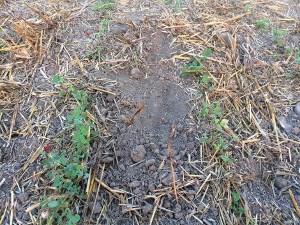Contact
Department of Crop Production Ecology, Ogräsekologi

Half the surface tilled – using row hoeing and under-sown subsidiary crops
Project responsible: Göran Bergkvist, Department of Crop Production Ecology, SLU.
Project group: Elsa Lagerquist, Department of Crop Production Ecology, SLU, Per Ståhl and Anita Gunnarsson at The Rural Economy and Agricultural Societies in Östergötland and Skåne, respectively, Josef Appell and Joel Månsson, in collaboration with Gothia Redskap.
The overall aim is to develop a cropping system that benefit soil fertility, where the risk of erosion and nutrient leaching is small, and where weeds, pests and diseases can be controlled – but still provides the necessary conditions for large and sustainable yields, with a high proportion of cash crops in the rotation.
We want to achieve this by substantially reduce soil tillage, have crops growing during the whole year, and by using modern technology for weed control.
In our proposed system we will grow cereals sown in bands with wide row spacing in combination with row hoeing and under-sown subsidiary crops (SC). With modern row traction technology it is possible to sow different crops and till the soil in parallel rows. This means that we during a spring cereal – winter cereal crop sequence will be able to till the whole soil surface for weed control and at the same time use SCs to create good conditions for the second consecutive cereal crop.
The goal of the proposed project is to optimize the critical crop sequence, spring cereal – winter cereal, regarding yield, nitrogen use and weed control. We will use oats as model for spring cereals and winter wheat as model for winter cereals. We will compare under-sowing of different types of legume SCs and different row patterns for under-sowing of SCs. We will conduct on-station field experiments and full scale on-farm field experiments.
The on-station experiment will be used to optimise patterns of under-sowing and row hoeing depending on type of legume SC. The full scale on-farm experiment will be used to compare selected treatment combinations using commercially available farm equipment.
Summary of the Final report 2021 (the complete Final report will be included later)